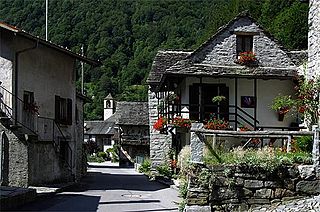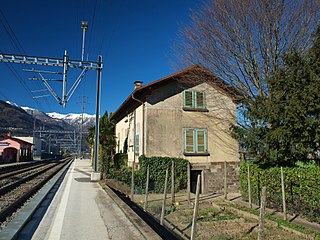
The river Ticino is the most important perennial left-bank tributary of the Po. It has given its name to the Swiss canton through which its upper portion flows.

Locarno is a southern Swiss town and municipality in the district Locarno, located on the northern shore of Lake Maggiore at its northeastern tip in the canton of Ticino at the southern foot of the Swiss Alps. It has a population of about 16,000 (proper), and about 56,000 for the agglomeration of the same name including Ascona besides other municipalities.

There are 106 municipalities in the canton of Ticino, Switzerland,. Municipalities (comuni) are grouped in circles (circoli) which are part of districts (distretti).

Bellinzona is a municipality, a historic Swiss town, and the capital of the canton of Ticino in Switzerland. The town is famous for its three castles that have been UNESCO World Heritage Sites since 2000.
The Locarno District is a district of Canton Ticino, Switzerland. It has a population of 63,774.

Olivone was a municipality in the district of Blenio in the canton of Ticino in Switzerland.
Bignasco is a village in the district of Vallemaggia, in the canton of Ticino, Switzerland, consolidated into the adjacent municipality of Cevio.

Gudo is a former municipality in the district of Bellinzona in the canton of Ticino in Switzerland.

Brione (Verzasca) is a village and former municipality in the district of Locarno in the canton of Ticino in Switzerland. On 17 October 2020 the former municipalities of Vogorno, Sonogno, Corippo, Brione (Verzasca) and Frasco merged to form the new municipality of Verzasca.

Magadino is a former municipality in the district of Locarno in the canton of Ticino in Switzerland.
Gerra (Verzasca) is a part of the municipality of Cugnasco-Gerra in the district of Locarno in the canton of Ticino in Switzerland.

Monte Ceneri is a mountain pass in the canton of Ticino in Switzerland. It connects the Magadino Plain and the Vedeggio Valley across the Lugano Prealps at an elevation of 554 metres (1,818 ft) above sea level. It provides the most direct route between the cities of Bellinzona and Lugano. Despite its name, Monte Ceneri is the lowest point on the crest between Monte Tamaro and the Camoghè.

The Valle Verzasca is a valley in the Locarno district of the canton of Ticino, Switzerland. It comprises the municipalities of Mergoscia, Vogorno, Corippo, Lavertezzo, Brione, Gerra, Frasco, and Sonogno. As of 2004, the total population is 3,200. It is the most central valley of Ticino, and none of the passes out of the valley cross cantonal or national borders. The valley is formed by the river Verzasca and is situated between the Leventina and the Maggia and culminates at Pizzo Barone.

The Castles of Bellinzona are a group of fortifications located around the town of Bellinzona, the capital of the Swiss canton of Ticino. Situated on the Alpine foothills, the group is composed of fortified walls and three castles named Castelgrande, Montebello and Sasso Corbaro. Castelgrande is located on a rocky peak overlooking the valley, with a series of walls that protect the old city and connect to Montebello. Sasso Corbaro, the highest of the three castles, is located on an isolated rocky promontory south-east of the other two. The Castles of Bellinzona with their defensive walls have been an UNESCO World Heritage Site since 2000.

Cugnasco-Gerra is a municipality in the canton of Ticino, Switzerland. It was formed on January 1, 2009, through the merger of Cugnasco and Gerra.

Gambarogno is a municipality in the district of Locarno in the canton of Ticino in Switzerland. It was created on 25 April 2010 through the merger of the municipalities of Caviano, Contone, Gerra, Indemini, Magadino, Piazzogna, San Nazzaro, Sant'Abbondio and Vira.

Monteceneri is a municipality in the district of Lugano in the canton of Ticino in Switzerland. It was created on 21 November 2010 through the merger of the municipalities of Medeglia, Bironico, Camignolo, Rivera and Sigirino. The first mayor elected was Emilio Filippini, who held the position until 2016.1

The Giubiasco–Locarno railway is a railway in Switzerland. It was built by the Gotthard Railway Company on 20 December 1874 as part of the line through the Ticino valley. With the nationalisation of the Gotthard Railway on 1 May 1909, the line became part of the Swiss Federal Railways (SBB).

Verzasca is a municipality in the district of Locarno in the canton of Ticino in Switzerland.

Riazzino railway station is a railway station in the municipality of Locarno, in the Swiss canton of Ticino. It is an intermediate stop on the standard gauge Giubiasco–Locarno line of Swiss Federal Railways. The station opened at the end of 2008, replacing the former stop at Riazzino-Cugnasco.





















